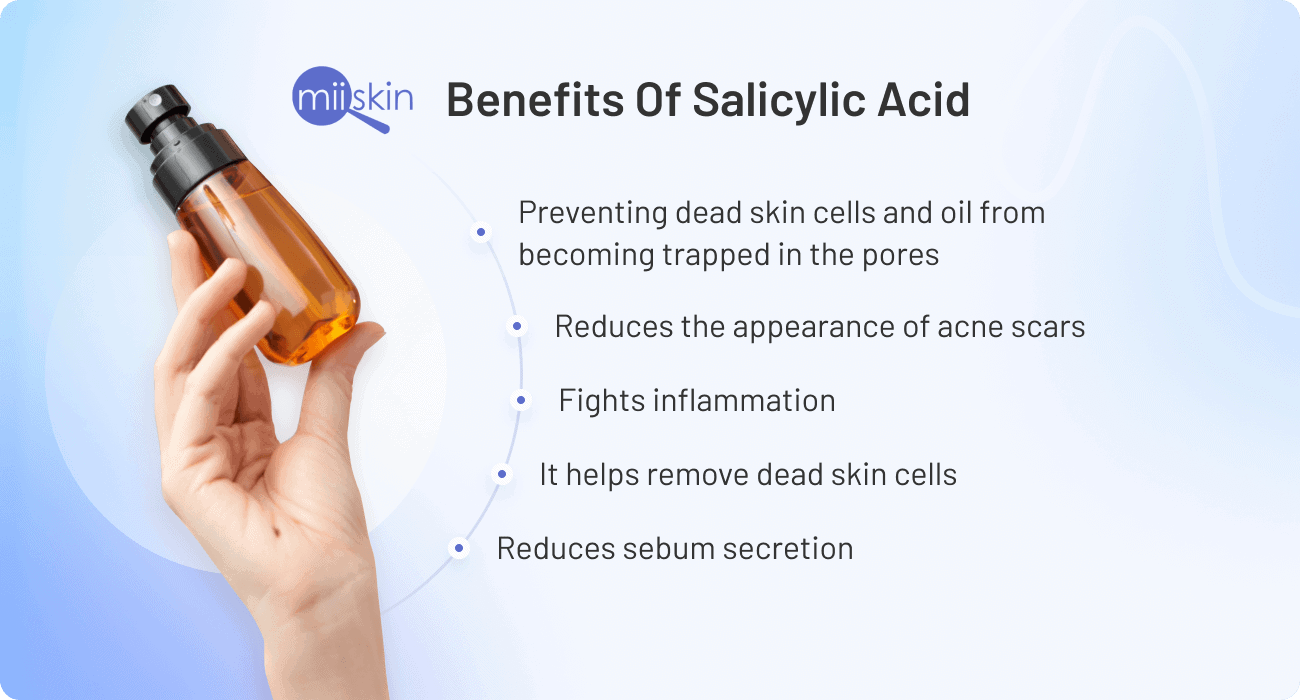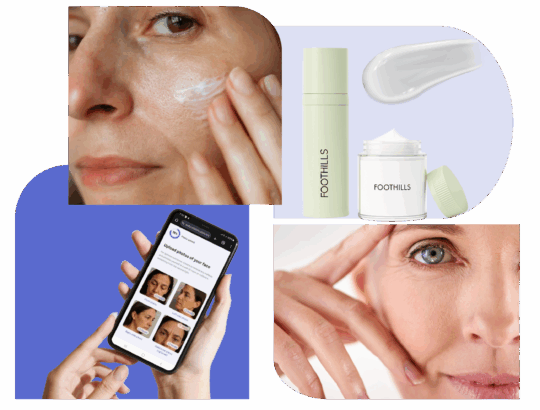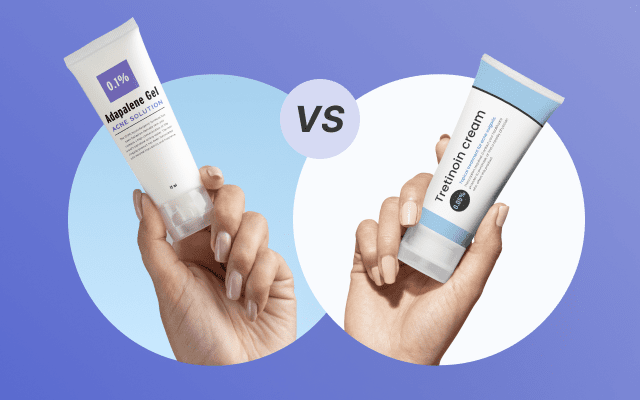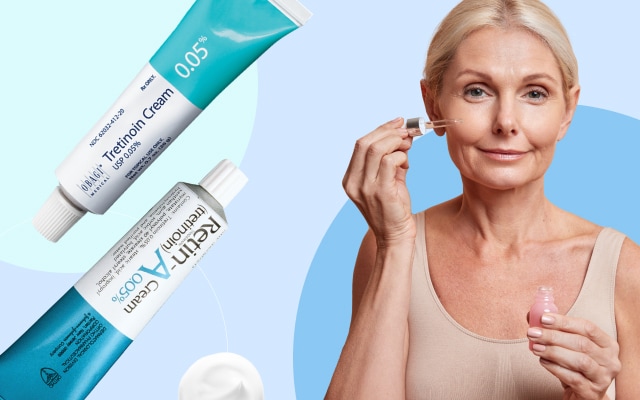Glycolic acid vs. salicylic acid: What are they and can you use them together?
Glycolic and salicylic acids are hydroxy acids commonly used in skincare due to their exfoliating properties, but they act very differently on the skin. Keep reading to find out how you can combine them to get radiant skin.
Table of Content:
What is the difference between glycolic vs salicylic acid? | Can you use them together? | Can you find them over the counter? | How to get a prescription? | What is glycolic acid and what does it do? | What is salicylic acid and what does it do?
Our commitment to producing high-quality content:
The information presented in this article is based on scientific research and the professional advice of our Content Medical Reviewers, who are experts in the field of Dermatology. How we write our content →
Glycolic acid and salicylic acid are two different types of hydroxy acids used in skincare and cosmetics for their exfoliating properties. But what if you are contemplating the idea of combining them?
In this article, we will answer the most common questions individuals have about glycolic acid and salicylic acid, mention the distinctive qualities of each, explore the potential synergy they might create when integrated together into your skincare routine, and will explain how to get a prescription to get a medication with these two ingredients.
If you are interested in learning more about hydroxy acids, you can also read our articles on salicylic and lactic acid, lactic and glycolic acid, benzoyl peroxide and salicylic acid, and retinol and glycolic acid.
Glycolic acid vs salicylic acid: what is the difference?
Glycolic and salicylic acid both have skin-rejuvenating properties although they have different mechanisms of action.
Glycolic acid primarily works on the outermost layer of the skin. It is a potent exfoliator that helps to remove the top layer of dead skin cells, revealing fresher, brighter skin underneath1. Salicylic acid can penetrate the deeper layers of the skin and is primarily known for its ability to exfoliate and unclog pores 2.
Can you use glycolic and salicylic acids together?
According to Dr. Carolina Fernandez, expert dermatologist, says “Yes, you can use glycolic and salicylic acid together if they are combined in the same product. It is not advisable to use different products with these ingredients in consecutive order. Glycolic and salicylic acids work well together. However, because you are using twice the active exfoliating ingredients, it is even more important to start slowly and pay attention to any sensitivity that may occur.
Consult a Board-Certified Dermatologist Now!

Download the Miiskin app to connect with independent, board-certified dermatologists who are licensed in your state. Answer a few questions, upload some photos and get a treatment plan in 1-2 days. Consultation price is $59 and medication renewals are only $39.
Online dermatology care is ideal for chronic dermatology conditions.
What not to mix with glycolic and salicylic acid?
When combined with vitamin C, which is also an acid, glycolic and salicylic acids should never be utilized. Because of the extreme instability of vitamin C, any acids you mix it with will disrupt the pH balance, making it completely ineffective before it has a chance to perform its magic.
Are glycolic and salicylic acid over the counter (OTC)?
You can buy many brands of glycolic and salicylic acid over the counter, however these products come in a low concentration. If you want to buy a product that includes glycolic and salicylic acid together with a high concentration, yes you need a prescription as these are potent ingredients that should only be used under medical supervision as they can be quite irritating on the skin.
How to get a prescription for glycolic and salicylic acid?
To get a prescription for glycolic and salicylic acid you can have a photo-consultation with a dermatology provider for only $59. You will get an answer in 1-2 working days together with your prescription, if medically adequate for you.
Can I get a formula that includes glycolic and salicylic acid?
Yes, you can get a customized formula via an online compounding pharmacy that includes a combination of prescription strength glycolic and salicylic acids.
Why should I use glycolic acid and salicylic acid in my skin care routine?
The skin is renewed approximately every 28 days, so the most superficial cells that are dead are shed naturally. However, certain circumstances, such as age, climate, indoor heating, air conditioning, stress, medication or health-related issues, can slow down the usual flaking phase.
When this happens, dead skin cells remain on the skin’s surface, making the complexion appear dull. In addition, a timely exfoliation helps skin care products penetrate the skin efficiently, so regular exfoliation is essential to a good skin care routine.
What is glycolic acid and what does it do?
Glycolic acid is the most used of the AHAs because it improves the appearance of photodamaged skin, reduces fine lines and wrinkles, smooths uneven skin texture, and reduces hyperpigmentation3 4.

What skin type is glycolic acid best for?
“Glycolic acid is not recommended for people with sensitive, reactive or dry skin. Let’s remember that the appearance of spots on the skin is an all too frequent problem. Therefore, whenever acids are used, regardless of their concentration, sunscreen should be used”, says Dr. Fernández.
“Glycolic acid products can come in a wide range of concentrations, and it’s always a good idea to see a dermatologist if you’re using concentrations higher than 10%,” says Dr. Fernández.
Precautions when using glycolic acid
Dr. Fernandez recommends avoiding glycolic acid under the following circumstances:
- Avoid using too many glycolic acid-containing products at the same time
- Do not use it if you have recently had microdermabrasion or any treatment that removes the top layer of your skin
- Discontinue use while being at the beach or exposed to the sun
- Do not combine it with other acne medication or cosmetics before consulting with your dermatologist
- Do not use it at the same time as any laser treatments
- Always use sunscreen when using glycolic acid
- If you wish to become pregnant, are pregnant or are breastfeeding, always consult your doctor before applying cosmetic products.
Can you combine glycolic acid with retinol?
According to Dr. Miller, you can incorporate both of these products into your skin care routine for acne and anti-aging. To learn more about the safe way of combining these 2 ingredients, read our article: Glycolic acid and retinol: can you use them together?
What is salicylic acid and what does it do?
Salicylic acid is BHA that works as a chemical peel, and it has been widely used; it is originally derived from the bark of willow trees7.
This ingredient has been widely used to address several skin problems, including acne, psoriasis, rough and bumpy skin (also known as keratosis pilaris), photodamage, and melasma8.
As part of a skincare routine for acne-prone skin, it can help leave your skin feeling softer and smoother because it supports the shedding of dead skin cells to reveal a healthy-looking complexion.

What skin types is salicylic acid best for?
“Since salicylic acid is better lipid soluble, it can penetrate clogged pores, decreases sebum secretion, making it especially beneficial for those with oily or acne-prone skin. Always use sunscreen responsibly. Be careful not to use other exfoliants to avoid adverse reactions. When in doubt, always consult a doctor,” says Dr. Fernández.
Precautions when using salicylic acid
“The precautions on the use of salicylic acid are the same as mentioned above, avoid using the same ingredient on several products, stick to lower concentrations unless you are under medical supervision, and always use sunscreen with SPF 50. If you wish to become pregnant, are pregnant or are breastfeeding, always consult your doctor before applying cosmetic products. Do not use topical acids on children. Topical salicylic acid in children may cause side effects. Tell your doctor before putting any type of cosmetic product on a child’s skin.” says Dr. Fernandez.
The takeaway
Although glycolic and salicylic acids are beneficial to the skin they should be used carefully and preferably under the supervision of a licensed healthcare professional as they can cause skin irritation, especially when used together or if you want to use a high concentration of these products.
For personalized skin care advice, talk to your online dermatologist so they can recommend the right products for your skin type.
Lee este artículo en Español Ácido glicólico y ácido salicílico: ¿Qué son y cómo se pueden usar juntos?
Need Expert Dermatologist Care?

Get expert advice from a licensed online dermatologist by simply uploading photos from your phone. If needed, a prescription (branded or generic depending on preference) will be sent directly to your favorite pharmacy. Nationwide coverage.
Skin conditions and treatments
Articles written in collaboration with dermatologists
Facial treatment for seborrheic dermatitis
How to get rid of rosacea permanently?
How to calm a rosacea flare-up fast?
Spongiotic dermatitis: What is it and what is the best treatment?
A dermatologist’s guide to psoriasis medication
Article References:
https://www.ncbi.nlm.nih.gov/pmc/articles/PMC3875240/
https://www.ncbi.nlm.nih.gov/pmc/articles/PMC4554394/
https://onlinelibrary.wiley.com/doi/10.1111/j.1524-4725.1996.tb00347.x
https://www.acs.org/molecule-of-the-week/archive/s/salicylic-acid.html#
https://www.ncbi.nlm.nih.gov/pmc/articles/PMC4554394/
https://pubmed.ncbi.nlm.nih.gov/30972839/







 Get a prescription for anti-aging!
Get a prescription for anti-aging!